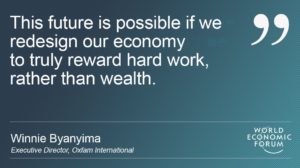
Globally, more than 800 million people are still living on less than US$1.25 a day, many lacking access to adequate food, clean drinking water and sanitation. Rapid economic growth in countries like China and India has lifted millions out of poverty, but progress has been uneven. Women are more likely to live in poverty than men due to unequal access to paid work, education and property.
During the four days of last week’s meeting, Oxfam predicted the assets of the world’s richest would increase by $8 billion. The report noted that 9 of every 10 billionaires is a man, and that women not only are paid less but also are more threatened with job insecurity.
At last year’s WEF, Oxfam reported that the global economic landscape produced one more billionaire every two days. A redistribution of this disproportionate distribution of wealth could potentially end extreme poverty globally seven times over.

Women in hot, overcrowded garment factories in Bangladesh paid poverty wages to stitch clothes for us to buy cheaply. Hotel housekeepers cleaning luxury rooms afraid to report sexual harassment for fear of losing their jobs. Poultry workers in the US – the richest country in the world – forced to wear nappies because they are denied toilet breaks. https://www.weforum.org/agenda/2018/01/we-have-built-an-unequal-world-heres-how-we-can-change-it/?utm_content=buffer733f9&utm_medium=social&utm_source=twitter.com&utm_campaign=buffer
“Dangerous, poorly paid work for the many is supporting extreme wealth for the few. Women are in the worst work, and almost all the super-rich are men. Governments must create a more equal society by prioritizing ordinary workers and small-scale food producers instead of the rich and powerful.”
The World Bank last year began including developed countries in calculations of the global poverty-line. These calculations determined that 3.2 million US citizens are among the 769 million worldwide surviving on less than $1.90 a day. In a report last week for the New York Times, Angus Deaton suggests yet another parameter in global poverty caculations would determine that The U.S. Can No Longer Hide From Its Deep Poverty Problem
Applying “needs-based absolute poverty-lines” to calculations renders 5.3 million Americans “absolutely poor” by global standards.
This is a small number compared with the one for India, for example, but it is more than in Sierra Leone (3.2 million) or Nepal (2.5 million), about the same as in Senegal (5.3 million) and only one-third less than in Angola (7.4 million). Pakistan (12.7 million) has twice as many poor people as the United States, and Ethiopia about four times as many.
Officially, 14% of Americans live in dire poverty and that number is expected to increase significantly under policies of the current administration due to new tax legislation and expected cuts to health and welfare programs.
“A child who is born into poverty has almost no chance of getting out of poverty in today’s United States,” said Philip Alston, U.N. special rapporteur on extreme poverty and human rights. “Current trends in the United States are actually undermining democracy. Poor people have no chance of having their voices heard, no chance of influencing public policy.”
In the United States, 2016 research conducted by the National Women’s Law Center found that up to 16.3 million – or one in 8 – women live in poverty.
Poverty rates were particularly high for Black women (21.4 percent), Latinas (18.7 percent) and Native women (22.8 percent). Families headed by single mothers (35.6 percent) were 5.4 times more likely than married couple families to live in poverty. Nearly six in ten poor children (59.5 percent) lived in female-headed families in 2016.
 Alston notes that the return of hookworm in the Southern States is an indicator of how poverty is contributing to deficiencies in clean water and poor sanitation.
Alston notes that the return of hookworm in the Southern States is an indicator of how poverty is contributing to deficiencies in clean water and poor sanitation.
An NPR series The U.S. Thought It Was Rid Of Hookworm. Wrong details the return of the parasite, citing a study where 19 of 55 individuals tested positive for the worm.
“The American Dream is rapidly becoming the American Illusion, as the U.S. … now has the lowest rate of social mobility of any of the rich countries.” In 1981, the top 1 percent of adults earned on average 27 times more than the bottom 50 percent of adults. Today the top 1 percent earn 81 times more than the bottom 50 percent.
Extreme poverty returns to America.
